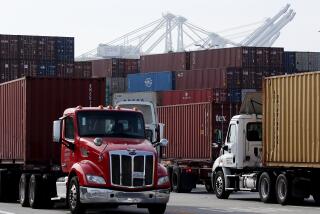Set for Long Haul : Truckers Finish Training to Take Part in McColl Cleanup
Autley (Corky) Thomas stroked his clean-shaven chin pensively, mourning his beard of 10 years, which he has sacrificed for Fullertonâs McColl dump.
âIt feels a little chilly,â he joked Wednesday in Anaheim, where he and 27 other truck drivers finished a three-day course qualifying them to participate in the massive cleanup of the World War II dump.
The beard came off because he was fitted Wednesday for a respirator to be carried--in case of an accident--in his truck when he hauls the sickeningly smelly waste to north Santa Barbara County. Beards could carry contaminated air into the driversâ breathing apparatus, the drivers were told.
But learning to use a respirator was only one of the safety procedures taught to the first specially trained truckers to work on a Superfund hazardous waste site in California, according to their instructor, Keith Walsh, director of hazardous waste material training for Med-Tox Associates of Tustin, an occupational and environmental health consulting firm.
The 24 hours of instruction also included discussions about the nature of the McColl waste by a toxicologist, the rules of the road, the layout of the Fullerton site and the route to the Casmalia Resources hazardous waste landfill.
The drivers also were briefed on how to inspect the tractor-trailer rigs, fill out hazardous waste manifests, maintain daily logs and behave at the scene of an accident, said Walsh, a former California Highway Patrol sergeant.
As of July 1, truck drivers hauling hazardous waste will have to meet minimum training standards set by the state Department of Health Services.
The training for McColl drivers satisfies the new requirements âand even goes further,â stressing precautions to be taken specifically along the Fullerton-to-Casmalia route, said Woody Gibson, special projects manager with Crosby & Overton Inc. of Long Beach, which is in charge of McColl waste transportation.
The truck drivers will not load the sulfur dioxide-laden waste in Fullerton and will be minimally involved in unloading at the landfill, Gibson said. The waste will be sealed shut inside plastic liners in the trailers, which will be covered with a tarp, he said.
âEven if it (the truck) tips over, it probably wouldnât spill or smell,â Gibson said.
Still, the drivers will be prepared for problems, he said.
The driversâ health will be monitored by Med-Tox throughout the cleanup, and the truckers at all times will carry full-mask respirators and such safety clothing as boots, gloves and chemical-resistant paper suits, he said.
âThese are over-precautions,â Gibson said. âBut we are erring on the side of safety.â
A second class of drivers will go through the same training closer to the McColl excavation start-up, now tentatively set for May 1, and at about that time the first class will attend a refresher course, he said.
The drivers are being supplied by Translabor Leasing Corp. of Pico Rivera, which placed ads seeking truckers for the 14-to-20-month job. More than 200 responded and 60 were selected, said Rhonda Barnett, a Translabor field representative.
The 60 underwent physical examinations, which screened out 12. The drivers had to demonstrate they have healthy lung capacity and no trace of cancer, heart or blood disease, Barnett said. Women were advised that if they became pregnant during the project they would be taken off the job and were urged to not apply if they planned to have children during the next two years, she said. Women truck drivers will be given monthly blood tests to detect pregnancy early, Barnett said.
Those precautions do not bother Joyce Grijalva of Upland, the sole woman in the first class. âIâve got three children. Threeâs enough,â she said.
Grijalva, a truck driver for five years who declined to give her age, said she is not nervous about hauling hazardous waste. The open classroom discussion about the chemicals âput my mind at ease,â she said. âI like the idea of being monitored by a doctor. Iâll see a doctor more now than I did before.â
Another driver, Dick Harris, 36, of Norco, said: âNobodyâs trying to hide anything from me.â Harris added that he felt the risks connected with hauling the waste âare not any more than walking outside and breathing the air.â
Barnett said the McColl job is attractive because it offers steady employment for almost two years, a pleasant route and three-day weekends. (Drivers will work four 11-hour days each week.)
Hardly Recognized Himself
Still, Barnett said, one drawback was the no-beards rule. She said Translabor received Department of Motor Vehicles photographs of all applicants and those with beards were promptly told of the rule.
âOne man walked out of the office when he heard that,â she said. âI had one guy just slam the phone down in my ear.â
For Corky Thomas of Anaheim, the no-beards edict meant thinking âtwice, or three or four timesâ about taking the job. He had grown attached to his facial hair, but the fact that he could keep his mustache--which spawned his CB name âHandlebarsâ--mollified him a bit, he said.
Thomas, 35, waited until almost the last minute, the night before final class, to shave off the beard. A divorced father, he wondered if his 2-year-old daughter would recognize him the next time she visits. He hardly recognized himself, he said.
âAnd I told them (Translabor) Iâd send them the medical bills if my dog bit me when I got home,â he said with a laugh.
More to Read
Sign up for Essential California
The most important California stories and recommendations in your inbox every morning.
You may occasionally receive promotional content from the Los Angeles Times.










